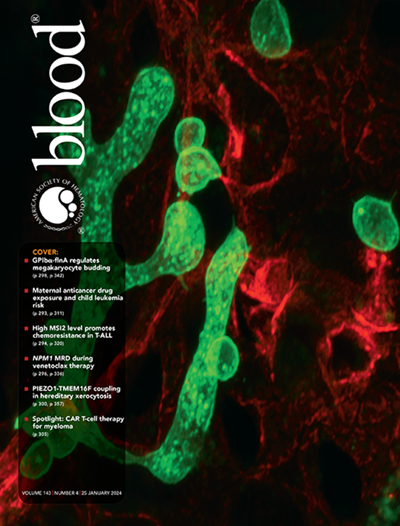转录重塑塑造急性淋巴细胞白血病对坏死下垂的治疗易感性。
IF 21
1区 医学
Q1 HEMATOLOGY
引用次数: 0
摘要
癌细胞根除不足和耐药克隆的存活是导致复发的主要原因。潜在的分子机制包括激活促生存和抗凋亡信号导致细胞凋亡不足和耐药。发现替代凋亡的程序性细胞死亡途径为拮抗凋亡逃逸途径开辟了可能性。我们之前已经表明,急性淋巴细胞白血病(ALL)具有明显的倾向,通过ripk1依赖性的坏死坏死发生细胞死亡,由小分子第二线粒体衍生的半胱氨酸酶激活剂(SMAC)模拟物激活。尽管在临床试验中证明了SMAC模拟物的安全性和耐受性,但它们作为单一药物的疗效似乎仍然有限,这突出了联合治疗的必要性。在这里,我们研究到目前为止尚未探索的坏死性坏死的调节机制,并确定干扰目标,以增强坏死性抗白血病反应。骨髓微环境模型中的体外药物反应分析揭示了组蛋白去乙酰化酶抑制诱导坏死性下垂的强大协同作用。随后的转录组分析和体内功能CRISPR筛选确定了通过主转录调控因子SP1、p300和HDAC2驱动坏死性坏死的基因调控回路。虽然SP1或p300的缺失对坏死坏死具有抗性,但HDAC2的缺失会使SMAC模拟物对ripk1依赖性细胞死亡敏感。因此,我们的数据表明,在患者源性人类白血病模型中,联合坏死下垂诱导和HDAC抑制具有很强的体内抗白血病活性。因此,necroptosis激活的转录依赖性是识别新干扰靶点的关键调控机制,指出了利用替代的非凋亡细胞死亡途径来根除抗性疾病的策略。本文章由计算机程序翻译,如有差异,请以英文原文为准。
Transcriptional remodeling shapes therapeutic vulnerability to necroptosis in acute lymphoblastic leukemia.
Insufficient eradication of cancer cells and survival of drug tolerant clones are major relapse driving forces. Underlying molecular mechanisms comprise activated pro-survival and anti-apoptotic signaling leading to insufficient apoptosis and drug resistance. The identification of programmed cell death pathways alternative to apoptosis opens up for possibilities to antagonize apoptosis escape routes. We have earlier shown that acute lymphoblastic leukemia (ALL) harbours a distinct propensity to undergo cell death by RIPK1-dependent necroptosis, activated by small molecule second mitochondria-derived activators of caspase (SMAC) mimetics. Despite demonstrated safety and tolerability of SMAC mimetics in clinical trials, their efficacy as single agent appears still limited, highlighting the need for combinatorial treatments. Here, we investigate so far unexplored regulatory mechanisms of necroptosis and identify targets for interference to augment the necroptotic anti-leukemia response. Ex vivo drug response profiling in a model of the bone marrow microenvironment reveals powerful synergy of necroptosis induction with histone deacetylase inhibition. Subsequent transcriptome analysis and functional in vivo CRISPR screening identify gene regulatory circuitries through the master transcription regulators SP1, p300 and HDAC2 to drive necroptosis. While deletion of SP1 or p300 confers resistance to necroptosis, loss of HDAC2 sensitizes to RIPK1-dependent cell death by SMAC mimetics. Consequently, our data inform strong in vivo anti-leukemic activity of combinatorial necroptosis induction and HDAC inhibition in patient-derived human leukemia models. Thus, transcriptional dependency of necroptosis activation is a key regulatory mechanism that identifies novel targets for interference, pointing out a strategy to exploit alternative non-apoptotic cell death pathways to eradicate resistant disease.
求助全文
通过发布文献求助,成功后即可免费获取论文全文。
去求助
来源期刊

Blood
医学-血液学
CiteScore
23.60
自引率
3.90%
发文量
955
审稿时长
1 months
期刊介绍:
Blood, the official journal of the American Society of Hematology, published online and in print, provides an international forum for the publication of original articles describing basic laboratory, translational, and clinical investigations in hematology. Primary research articles will be published under the following scientific categories: Clinical Trials and Observations; Gene Therapy; Hematopoiesis and Stem Cells; Immunobiology and Immunotherapy scope; Myeloid Neoplasia; Lymphoid Neoplasia; Phagocytes, Granulocytes and Myelopoiesis; Platelets and Thrombopoiesis; Red Cells, Iron and Erythropoiesis; Thrombosis and Hemostasis; Transfusion Medicine; Transplantation; and Vascular Biology. Papers can be listed under more than one category as appropriate.
 求助内容:
求助内容: 应助结果提醒方式:
应助结果提醒方式:


